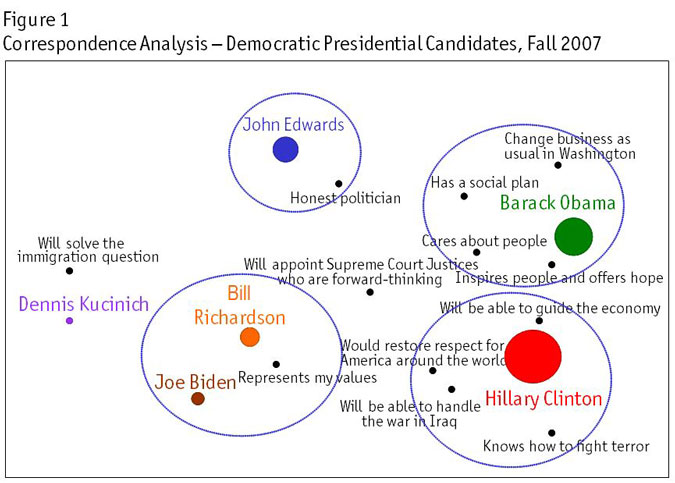Editor's note: Michael Lieberman is founder and president of Multivariate Solutions, a New York research firm. He can be reached at 646-257-3794 or at michael@mvsolution.com.
This article appeared in the April 9, 2012, edition of Quirk's e-newsletter.
As the race for the Republican 2012 presidential nomination rages on, Americans are tasked with keeping straight the candidates and what each stands for. While Republican candidates' platforms bear many similarities, their slight differences are what set them apart from one another. Research can be used to determine these differences, also known as wedge issues, and guide candidates on how to best position themselves to garner the most swing votes possible.
This article explores the use of a political visual: the perceptual map. This visual, often implemented in branding and advertising research, can be used to demonstrate a candidate's early position and movement as the campaign progresses and to identify wedge issues and what influences undecided voters.
Begins with a candidate
A political campaign begins with a candidate. Regardless of the party or office sought, each candidate must first consider some very basic questions: Who am I politically? What do I want to achieve? Why I am uniquely qualified? The answers to these questions define the candidate's public profile, otherwise known as his/her political brand.
Campaign research starts with a baseline survey or poll - asking carefully-worded questions to a scientifically-selected sample of people via phone, online or face-to-face - to analyze the issue environment, demographics, party affiliation and relative positive and negative images of the candidates. The polling data and research must be analyzed further to facilitate understandable, effective strategic and tactical decisions.
Visually displays
Perceptual mapping is a graphical marketing research technique that visually displays the perceptions of consumers or, in this case, voters. Typically the position of a product, product line, brand or company is displayed relative to their competition. Early in the survey, respondents are asked for whom they intend to vote. Later, they are shown an array of issues.
For the purposes of this article, consider a fictional example wherein 11 key descriptions were shown regarding the major candidates vying for the 2008 Democratic presidential nomination (Barack Obama, Hillary Clinton, John Edwards, Joe Biden, Bill Richardson and Dennis Kucinich). The survey can be designed one of two ways:
- Numerical scale (e.g., "On a scale from one to 10, how much does this attribute describe [candidate]?")
- Yes/no (e.g., "Does [attribute] apply to [candidate], yes or no?")
The advantage of using a numerical scale is that it allows more variability in the data and will likely produce a clearer map. However, in a crowded primary, when there are several candidates, it is more efficient to have respondents evaluate candidate descriptions with a yes/no, particularly if the survey is done over the phone.
Below is the candidate picture as the campaign heads into full swing (Figure 1). This initial perceptual map has an added dimension: The size of the candidate's circle represents their current support. Thus, the map illustrates both the level of support and the basis of support.
At this point in the campaign, Hillary Clinton is leading with a solid basis of "experience and competency." Her main opponent at the time, now-President Barack Obama, is seen as a more human candidate whose strength lies in change, social responsibility and inspiration. John Edwards' main support is honesty(!), while support for dark-horse candidates Bill Richardson and Joe Biden lies mainly with people who identify with them personally.
Finding wedge issues
Wedge issues are those which are owned by neither political party but can sway undecided voters. The survey construction for a wedge issue perceptual map is similar to the original. It can be numerical or yes/no and the issues that land near the "undecided" option are considered wedge issues. Using a fictional local race as an example, the resulting perceptual map looks like this:
Examining the map in Figure 2, there are no surprises. The key Democrat attributes are in line with core Democratic issues. The Republican challenger is running on Republican standards.
But in this local race, there are four wedge issues - that is, four issues that no party candidate owns. One issue, affordable health care, lands between Democratic and Undecided. This presents an opportunity for the Democratic candidate to own the issue and earn swing votes. Three other issues - increasing funding for local schools, improving the transportation system and creating more electricity to meet increasing demand - are up for grabs for either party. These are the issues upon which the outcome will most likely be decided if Democratic and Republican support is otherwise relatively equal.
Easily understood
The advantage to using perceptual maps is that they are easily understood. Any political strategist or campaign manager can glance at the visual and grasp the strategic implications, no matter their statistical background. The analysis can be filtered by various voter blocs to produce multiple maps. Survey design is also easy to field and, in the polling business, the length of questionnaire is time and time is money.
